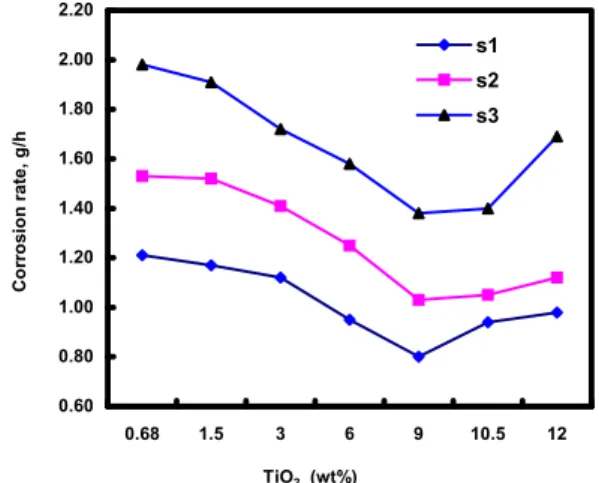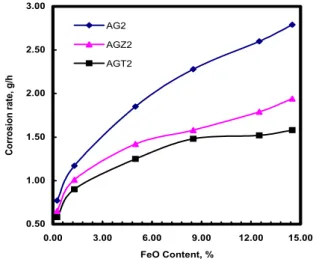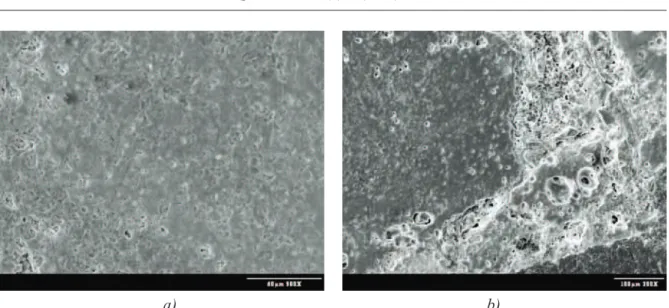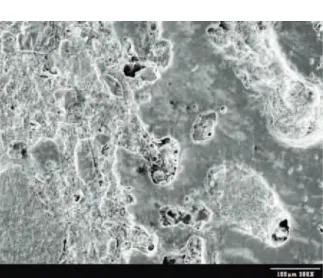INTERACTION MECHANISM BETWEEN REFRACTORY AND
MELTS IN IRON BATH SMELTING REDUCTION PROCESS
G.B. Qiu*#and Y. Xu*
*College of Material Science and Engineering, Chongqing University, 174 Shapingba Main Street, Chongqing, 400030, P. R. China
(Received 02 October 2010; accepted 30 October 2010)
Abstract
The corrosion behavior of three sorts of refractories based on alumina-graphite were studied by immersion tests. The melts included smelting reduction molten slag and corresponding carbon saturated molten iron. The influence of test temperature, FeO content in slag and specimen rotative velocity on the corrosion rate of refractories was examined. By means of SEM and EDS, the microstructure change of the refractories after immersion test in kinds of melts was studied. The morphology of the deteriorated layer showed the corrosion extent of refractories. With the addition of zirconia and titania into the refractories, the corrosion rate changed to some extent. The corrosion rate of three sorts of refractories increased dramatically with the increasing FeO content in smelting reduction slag. Compared with alumina-graphite refractory and alumina-graphite-zirconia refractory, alumina-graphite-titania refractory had stronger corrosion resistance in the smelting reduction conditions. By the results of SEM and EDS, the corrosion mechanism of refractories was developed.
Keywords:Refractories based on alumina-graphite; Smelting reduction; Corrosion mechanism; Microstructure
#Corresponding author: qiuguibao@cqu.edu.cn
J o u r n a l o f
M i n i n g a n d
M e t a l l u r g y J. Min. Metall. Sect. B-Metall. 46 (2) B (2010) 131 - 140
1. Introduction
Smelting reduction process with iron bath is a typical smelting reduction technology.
The corrosion resistance of the refractories against the molten bath is one of the imperative and tough problems for the development of smelting reduction [1-4].
132 G. Qiu / JMM 46 (2) B (2010) 131 - 140
The chemical composition and oxidation behavior of the smelting reduction melts with iron bath are much more complicated than those of the blast furnace technology [2, 5-8]. The properties of the melts are changed dramatically and continuously in the melting process. On the other hand, the behavior of the melts depends greatly on the activity of FeO and the reduction rate of iron oxides in the molten bath [7-9]. Due to the high concentration of FeO in slag and high reduction rate of iron oxides in the molten bath, the corrosion behavior and corrosion mechanism of the refractories in smelting reduction melts are the key factors in development of the smelting reduction technology. Up to now, improving refractory quality of corrosion resistance of melts, developing high quality and long service life refractories used as the lining refractory materials of the molten bath are still the most important mission for developing smelting reduction technology.
Alumina-graphite refractory (AG) and alumina-graphite-zirconia refractory (AGZ) have been used in metallurgical industry successfully for many years. They are widely used in blast furnace, convertor, electric arc furnace [7,8,10-15]. But it is imperative to investigate the corrosion mechanism of different refractories in the melts of smelting reduction with iron bath, to control the corrosion reaction and to decrease the corrosion rate of refractories efficiently.
This investigation focused on studying the physical properties, corrosion behavior, corrosion rate, investigating the main factors that affect the corrosion process of refractory lining in smelting reduction technology with iron bath and examining the microstructure
change for the alumina-graphite based refractories, AG, AGZ and alumina-graphite-titania (AGT).
2. Experimental
The specimens of the alumina-graphite based refractory (AG, AGZ and AGT) were applied in this study. AG refractory specimen was made from the finished product that has been used as the lining materials of the electric arc furnace (Chongqing Special Steelmaking Co.). AGZ and AGT refractory specimens were prepared in laboratory, shaped and sintered in refractory factory (Refractory Factory of Chongqing Iron and Steel Co.). These bricks were sintered in high temperature furnace (the service temperature over 1800°C) in the reduction atmosphere. The properties of the refractories are listed in the table 1.
The Smelting reduction melts consisted of molten slag and iron bath. The composition of slag is shown in table 2. Slag specimens were made of the blast furnace slag (from Chongqing Iron Making & Steel Making Co.) and chemical agents (Shanghai Chemical Agents Co.). The slag grain of immersion test was made by melting the mixture of the blast furnace slag and chemical agents in advance. The iron bath was composed of pig iron scrap (from Chongqing Iron Making & Steel Making Co.). Its composition was (%wt): C 4.16, Si 0.53, Mn 0.32, P 0.10 and S 0.034. Before the testing, iron bath was saturated with carbon, using a graphite block on the bottom of the crucible at 1500 °C for three hours.
immersion, in electric resistance furnace respectively. Experimental method and experimental condition were the same as reference [8]. The specimen of refractory was 50mm immersed into molten bath. The experimental temperature was designed between 1723K and 1923K. The composition of the atmosphere in the molten bath was maintained CO 30%, N2 60% and CO2 10% in volume. The solid grain slag was added into the crucible after the iron scrap melted completely. The refractory specimen was immersed into melts when the temperature of the bath reached the designed level. The corrosion behavior was examined by measuring the diameter change and the mass loss of refractory specimen after the immersion tests.
The test results of corrosion are expressed as the corrosion rate Vc, which is calculated according to the equation 1:
....(1)
Where D0 is the original diameter of the refractory specimen (millimeter), Dt is the diameter of the specimen after the immersion test (millimeter), H is the immersion depth of specimen (millimeter), rsis the density of the refractory specimen (milligrams per cubic millimeter), t is the immersion time (minute), Vc has the unit of g/h.
Scanning electron microscopy (SEM), X-ray diffraction and X-X-ray Spectrum were used to examine the composition and structure change of the wear surface and the deteriorated layer during the immersion test. This examination is helpful to investigate the corrosion mechanism of the refractory in the melts of smelting reduction with iron bath.
3. Results and discussion
The properties, structures and the corrosion behavior of alumina-graphite based refractories in smelting reduction melts with iron bath had been studied
[7,8,15]. A linear relationship between the FeO content of melts and the corrosion rate of refractories was observed. The corrosion
Table 1. Chemical compositions and physical properties of the refractories
Table 2. Chemical composition of slag (wt.%)
Specimens AG1 AG2 AG3 AGZ1 AGZ2 AGZ3 AGT1 AGT2 AGT3
Al2O3 (%) 76.75 74.6 72.8 71.58 68.35 66.02 72.93 70.52 68.72
SiO2 (%) 11.2 10.4 9.63 10.17 9.5 8.14 9.18 8.65 7.12
C (%) 4.45 7.64 9.8 9.9 9.8 9.8 9 9.05 9
ZrO2 (%) 0.12 0.11 0.1 3 6 9 0.12 0.11 0.11
TiO2 (%) 0.68 0.66 0.65 0.67 0.66 0.65 3 6 9
CCS (MPa) 41.95 44.74 44.97 42.53 39.65 39.95 41.85 43.12 39.28
MOR (MPa) 15.45 16.68 15.5 15.36 14.45 15.66 16.5 16.86 16.6
Porosity (%) 5.38 5.52 5.41 5.81 5.92 6.14 5.42 5.35 5.55
Density (g/cm3) 2.79 2.76 2.76 2.75 2.74 2.78 2.7 2.73 2.71
Slag
specimen FeO CaO MgO SiO2 Al2O3Balance
S1 1.3 38.8 9 31 9.5 4.4
S2 8.5 35.5 9 34.5 9.5 3
S3 14.5 32.5 9 31 9.5 3.5
133
G. Qiu / JMM 46 (2) B (2010) 131 - 140
Vc H D D
t
s t
= ( 0 − ) ×
2
4
rate decreased with the increasing carbon content in the refractories when the carbon content was in the range from 2% to10%.
ZrO2 has been used in metallurgy industry and refractory production as an addition materials for many years [7,11]. The refractory brick containing ZrO2 has been widely used in high temperature furnace or kiln. But the condition in the melts of smelting reduction with iron bath is much more complex than other metallurgical processes. The corrosion behavior of refractories in the melts of smelting reduction with iron bath is quite different from that of blast furnace. Table 3 was the test results of the relationship between the corrosion rate and the ZrO2 content of refractories. The test results show that the higher the ZrO2 content in refractory, the lower the corrosion rate of the refractories in smelting reduction melts. ZrO2 has a good corrosion resistance of smelting reduction melts with iron bath. The reasonable content of ZrO2 in the AGZ refractory is 6~9% for smelting reduction technology.
The investigation of the microstructure of AGT refractory shown that the major morphology of Ti in refractory is a well developed TiC network when TiO2content is 6~9% [8]. The random distribution C decreased evidently in refractory as the TiO2
content increased extremely. The TiC network improves properties and the corrosion-resistance of the refractory.
Figure 1 is the test results of the corrosion rate of AGT refractories. Table 1 gives the properties of the AGT refractories and the strength at the high temperature (MOR) is higher and the porosity is lower than that of the AG and AGZ refractories in the same condition. The melting point of TiC is fairly high (above 3290K). When the molten slag covers refractory, the corrosion reactions will occur and graphite carbon will be oxidized and porosity increases. The molten slag penetrated refractory through the pore and crack. Meanwhile, the TiC network will be broken and the TiC particles distribute in the slag film and the interface between melts and refractory. This effect will decrease the flowability behavior of the slag film and the melts greatly and decrease the kinetic tendency of the corrosion reaction between the refractory and molten slag. The result is the rate of corrosion reaction between refractory and melts is decreased gradually.
When the TiO2 content is over 10%, the
G. Qiu / JMM 46 (2) B (2010) 131 - 140
134
Table 3. Test results of the corrosion rate for AGZ refractories (g/h)
Fig.1. Relationship between the TiO2content and the corrosion rate of refractory
ZrO2(%) 0.11 1.5 3 6 9 10
S1 1.22 1.15 1.02 0.93 0.89 0.89
S2 1.61 1.55 1.28 1.21 1.18 1.18
S3 1.97 1.75 1.69 1.51 1.52 1.48
0.60 0.80 1.00 1.20 1.40 1.60 1.80 2.00 2.20
0.68 1.5 3 6 9 10.5 12 TiO2 (wt%)
C
o
rro
si
o
n
ra
te
,
g
/h
corrosion increases slowly. This phenomenon is related to the TiC network structure and the reduction of the TiO2 or other titanium oxides existing in the refractory. The structure study of the AGT shows that there are TiO2 and titanium oxides compounds in the refractory if the content is over 10% with 9% carbon [8]. The reasonable content of TiO2 is 6-9% for the alumina-graphite based refractory with 9-10% carbon content.
The corrosion behavior and the mechanism for several kinds of refractories in the melts of smelting reduction technology have been investigated in detail. FeO concentration and activity are the important factors that affect the corrosion behavior of refractories [2, 4, 6, 9]. A test result of studying the relationship between FeO concentration and corrosion rate is shown in figure 2. The corrosion rate of refractory increases as a linear relationship with the FeO content in the smelting reduction melts. The corrosion resistance of the refractories decreases with the increasing FeO of the
melts. The AGT refractories exhibit relatively good anti-corrosion characteristic among the three types of refractories, especially in high FeO concentration melts. The oxidization of the melts increases with increasing FeO content. The reaction rate between the melts constituent and the refractory is related to the oxidization capacity of the melts. The carbon graphite contained in the refractory is an active reducing agent of the ferrous oxidizes. During the immersion test, the graphite carbon contained in refractory will reduce FeO of the melts and produce metal Fe and gaseous CO, the pore and crack will appear in the reaction layer of refractory. This effect will improve the kinetic condition of the corrosion process and the penetrating rate of melts refractory. The AGZ refractory contains ZrO2 which behaviors a good anti-oxidization ability. TiC, forming a well-developed network structure in the AGT refractories, with high melting point, improves the anti-corrosion of AGT refractory evidently. The AGT refractories is the best materials for anti-corrosion of the smelting reduction melts among the alumina-graphite based refractories (AG,AGZ and AGT).
Figure 3 is the test results of corrosion rate of refractories at the different test temperatures. It shows that the temperature of the molten bath is one of the important factors that influence the corrosion behavior of the alumina-graphite based refractory.
The corrosion rate of refractory increased rapidly with the increasing temperature. But the changing ratio of corrosion rate was less than that of FeO concentration of melts. The moving velocity of slag film and reaction
G. Qiu / JMM 46 (2) B (2010) 131 - 140 135
Fig.2. Test results of the influence of FeO content in melts on the corrosion rate of the refractories, 1773 k at the rotary immersion
0.50 1.00 1.50 2.00 2.50 3.00
0.00 3.00 6.00 9.00 12.00 15.00
FeO Content, %
Corrosion
rate,
g/h
AG2
AGZ2
between the melts and refractories will be speeded up when the temperature increases. On the other hand, increasing molten bath temperature would accelerate the mass diffusion in slag film, molten melts and deteriorated layer of the refractory. The reduction rate of FeO in melts would also increases and the stirring behavior of the molten bath by the heat motion and the gaseous CO produced in the reduction reaction would become fierce as the temperature increases.
The research results show that the higher the stirring speed, the higher the diffusion rate of mass in the molten bath [8, 16]. The moving speed of slag film of interface between refractory and molten slag increases as a linear function with the rotative velocity of refractory in smelting reduction melts. The test results of relationship between rotative velocity of alumina-graphite based refractory and corrosion rate are shown in the table 4. Corrosion rate of refractory
increases with the increasing rotative velocity of refractory. The influence of rotative velocity of the refractory specimen on the corrosion rate of AG refractory is much greater than that of AGT refractory under the same test condition.
In order to study the corrosion behavior and corrosion mechanism of the alumina-graphite based refractory in the smelting reduction melts, The microstructure of deteriorated layer of the refractory had been investigated by Scanning Electron Microscopy (SEM) and Energy Dispersive Scanning (EDS).
Figure 4 is the microstructure of the deteriorated layer of AG2 in melts of slag2 and iron bath. Figure 4a is the original structure of the AG2 refractory. The structures of AG refractory are corundum, mullite, α-Al2O3 and graphite. Figure 4b is the microstructures of the deteriorated layer of immersed AG2 refractory. The deteriorated layer of refractory was corroded greatly by melts. The structure was changed in evidence with the slag and iron penetrated.
G. Qiu / JMM 46 (2) B (2010) 131 - 140
136
Fig. 3. Relationship between the temperature of the melts and corrosion rate of refractory, with 8.5% FeO concentration in melts, rotative velocity 20r/min.
Table 4. Relation between rotative velocity of refractory and corrosion rate, g/h
0.00 1.00 2.00 3.00 4.00
1650 1700 1750 1800 1850 1900 1950
Temperature, K
corrosion
rate,
g/h
AG3
AGZ3
AGT3
Rotative
velocity, r/min 0 10 15 20 25 30
AG1 0.4 0.64 0.78 1.13 1.42 1.63
AG2 0.36 0.56 0.69 1.09 1.27 1.41
AG3 0.33 0.54 0.66 0.92 1.18 1.3
AGZ1 0.34 0.45 0.58 0.98 1.23 1.38
AGZ2 0.3 0.43 0.54 0.96 1.2 1.34
AGZ3 0.3 0.4 0.52 0.95 1.18 1.32
AGT1 0.31 0.46 0.53 0.93 1.14 1.15
AGT2 0.28 0.41 0.5 0.89 1.09 1.1
Interaction between melts and refractory has taken place and a lot of new compounds formed in the deteriorated layer of refractory. An evident phenomenon is graphite carbon almost oxidized and produces CO. The porosity increases dramatically. The compounds of slag and new oxides appear in the deteriorated layer.
Figure 5 is the composition of the interface between deteriorated layer and slag film. The metal iron, FeSi2O3, CaSiO3,
2FeSiO4 and SiO2 were found in the deteriorated layer of refractory. The graphite carbon was oxidized over 90% and no graphite carbon was found in the interface between deteriorated layer of the refractory and slag film.
Figure 6 is the microstructure of the AGZ2, immersed in melts of salg2 and iron bath, test temperature 1773K with the rotative velocity 15r/min. The principal constituents of the AGZ refractory are zircon, zirconolite, corundum, mullite, α-Al2O3, and graphite. The structure change behavior of the AGZ refractory in the corrosion process was that graphite and Zirconia were partially disappeared, zirconolite, CaO·SiO2, Fe3C and metal Fe appeared in the deteriorated layer of the refractory. The structure of the refractory was damaged by the molten iron bath and slag penetrated. The interaction between melts and the refractory occurred and new compounds of FeO·SiO2 (melting point 1205oC), SiZrO
4, FeO·3CaO, 2CaO·SiO2
G. Qiu / JMM 46 (2) B (2010) 131 - 140 137
a) b)
Fig. 4 The microstructures of the AG2 refractory, immersion melts of salg2 and iron bath, test temperature 1773K, rotative velocity of refractory in melts 15r/min. (a) the original microstructure. (b) the deteriorated layer of refractory.
and CaO·SiO2were found in the deteriorated layer and slag film. The graphite carbon of the refractory had been oxidized nearly 90%. The porosity increases evidently. Figure 7 shows the composition of the AGZ2 in deteriorated layer. Compounds of SiO2, CaO, TiO2, FeO appeared in the deteriorated layer of refractory. Metal iron also exits in
the deteriorated layer and slag film.
Figure 8 is the microstructure of the deteriorated layer of AGT2 refractory. The principal constituents of the refractory are well-developed TiC network, mullite, α-Al2O3, and well-distributed graphite carbon. The structure of the AGT refractory was changed by the molten iron bath and molten slag penetrating refractory through the crack, aperture formed by the oxidizing reaction of graphite carbon. But the content of Fe, Ti and Ca is much lower than that of refractory AG2 and AGZ2 under the same condition.
The compounds of TiC, Fe3C, CaO·TiO2 and CaO·SiO2were found in the deteriorated layer. The graphite carbon was oxidized greatly and porosity increased. Figure 9 is the composition (EDS) of the deteriorate layer of refractory AGT2, test was at the temperature 1773K. The elements of Ti, Ca, Fe and Si appeared in the deteriorated layer of the refractory.
G. Qiu / JMM 46 (2) B (2010) 131 - 140
138
Fig. 6. The microstructures (SEM) of the AGZ2 refractory, immersion melts of slag2 and iron bath, test temperature 1773K, the rotative velocity of refractory in melts 15r/min. the deteriorated layer of refractory, melts penetrated.
Fig. 8. The microstructures (SEM) of the deteriorated layer of AGT2 refractory, immersion melts of salg2 and iron bath, test temperature 1773K, the rotative velocity 15r/min.
4. Conclusion
The corrosion rate of the alumina-graphite based refractories in melts of smelting reduction with iron bath was investigated in the condition of quasi-static immersion and rotary immersion. The corrosion rate of alumina-graphite based refractories decreases with the addition of TiO2and ZrO2 in the refractories. The important factors that influence the corrosion rate are iron oxides content of the melts, relative rotative velocity of refractory specimens in melts and the molten bath temperature. But the most important factor is iron oxides concentration of the melts.
The principal constituents of the alumina-graphite refractory are corundum, mullite, α-Al2O3, and graphite. During the corrosion test, the interaction between melts and the refractory occurred and the new compounds of FeO·SiO2 (melting point 1205oC),
SiZrO4, FeO·3CaO, 2CaO·SiO2 and CaO·SiO2 formed in the deteriorated layer. The graphite carbon was oxidized over 90% and porosity increased greatly in the deteriorated layer of refractory.
The corrosion behavior of AGZ refractory was that graphite and zirconia partially disappeared. Zirconolite, CaO·SiO2, Fe3C and metal Fe formed. The corrosion of the AGZ refractory was interaction between melts and the refractory and formed new compounds of FeO·SiO2 (the melting point 1205oC), SiZrO
4, FeO·3CaO, 2CaO·SiO2
and CaO·SiO2in the deteriorated layer. The graphite carbon was oxidized 70~80% and porosity increased.
AGT shows the best anti-corrosion character in the melts of smelting reduction with iron bath. The principal constituents of the AGT refractory are a well-developed TiC network, mullite, α-Al2O3, and graphite. The content of Fe, Ti and Ca in the deteriorated layer was much lower than that of refractory AG2 and AGZ2. The compounds of TiC, Fe3C, CaO·TiO2 and CaO·SiO2 were found in the deteriorated layer. The graphite carbon was oxidized 40~50%. TiC Network can improve the corrosion resistance of the alumina-graphite based refractory greatly.
Acknowledgments
This work supported by NSFC (51090383), the Key Project of Chinese National Programs for Fundamental Research and Development (2007CB613503) and SRF for ROCS, SEM.
References
[1] G.B. Qiu, C.G. Bai, L.Y. Dong, L.Y. Wen, D.F. Chen, C.S. Xu, Ironmaking & Steelmaking. 36(2008)105.
[2] I. Zivkovic, N. Mitevska, I. Mihajlovic, D. Nikolic, J. Min. Metall. Sect. B-Metall. 45(1)B (2009) 23.
G. Qiu / JMM 46 (2) B (2010) 131 - 140 139
[3] C.G. Aneziris, U. Klippel, W. Schaerfl, V. Stein, Y.W. Li, Int. J. Appl. Ceram. Technol. 4(2007)481.
[4] J. Hardtwy, Ironmaking & Steelmaking. 10(1983)124.
[5] Q.C. Liu, J. Iron Steel Res. Int. 3(1996)7-10.
[6] J. Astier, Iron & Steel Institute. 102(1967)126.
[7] D. Ghosh, V. Krishnamurthy A. and S.R. Sankaranarayanan, J. Min. Metall. Sect. B-Metall. 46B (2010) 41.
[8] Q.C. Liu, B.H. Zhang, T. Zhang, Iron and Steel, 12(1994)55.
[9] V. V. Lisnyak, J. Min. Metall. Sect. B-Metall. 45(1)B (2009) 131.
[10] W.A. Al-douri, T.J. Davies, A.A. Ogwu, H.G. Emblem, J Mater. Sci. Lett. 13(1994)1543.
[11] T. Asokan, J. Mater. Sci. Lett. 13(1994)343.
[12] C.F. Chan, Y.F. Ko, J. Am. Ceram. Soc. 75(1992) 2857.
[13] A. Muan, J. Am. Ceram. Soc. 75(1992)1319.
[14] H.Y. Yang, C.F. Chan, J. Am. Ceram. Soc. 73(1990)1074.
[15] Y. Xu, Q.C. Liu, C.G. Bai, D.F. Chen, J. Iron Steel Res. Int. 11(2004)4.
[16] Q.C. Liu, D.F. Chen, Y. Xu, British Corrosion J. 37(2002) 231.
G. Qiu / JMM 46 (2) B (2010) 131 - 140






